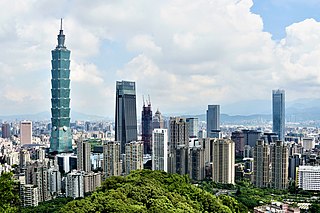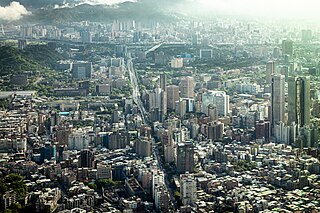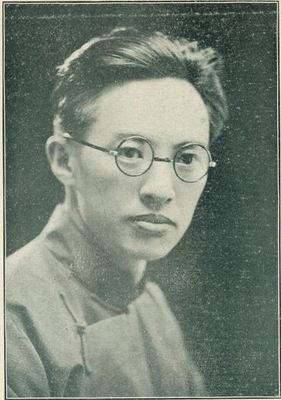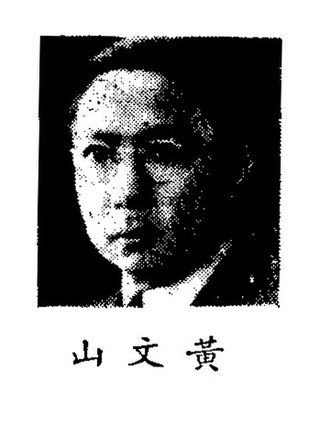
Taipei, officially Taipei City, is the capital and a special municipality of Taiwan. Located in Northern Taiwan, Taipei City is an enclave of the municipality of New Taipei City that sits about 25 km (16 mi) southwest of the northern port city of Keelung. Most of the city rests on the Taipei Basin, an ancient lakebed. The basin is bounded by the relatively narrow valleys of the Keelung and Xindian rivers, which join to form the Tamsui River along the city's western border.

The National Palace Museum, also known as Taipei Palace Museum, is a national museum headquartered in Taipei, Taiwan. Founded in Beijing in 1925, the museum was re-established in Shilin, Taipei, in 1965, later expanded with a southern branch in Taibao, Chiayi in 2015.

Sun Yat-sen was a Chinese physician, revolutionary, statesman, and political philosopher who founded the Republic of China (ROC) and its first political party, the Kuomintang (KMT). As the paramount leader of the 1911 Revolution, Sun is credited with overthrowing the Qing imperial dynasty and served as the first president of the Provisional Government of the Republic of China (1912) and as the inaugural Chairman of the Kuomintang.

The flag of the Republic of China, commonly called the flag of Taiwan, consists of a red field with a blue canton bearing a white disk surrounded by twelve triangles; said symbols symbolize the sun and rays of light emanating from it, respectively.

Soong Ch'ing-ling, Christian name Rosamonde or Rosamond, was a Chinese political figure. She was the wife of Sun Yat-sen, therefore known by Madame Sun Yat-sen and the "mother of modern China." A member of the Soong family, she and her family played a significant role in shaping the Republic of China. As a prominent leader of the left wing of the Kuomintang (KMT), she founded the Revolutionary Committee of the KMT. She entered the Communist government in 1949, and was the only female, non-Communist head of state of the People's Republic of China. She was named Honorary President of the People's Republic of China and admitted to the Chinese Communist Party (CCP), a few weeks before her death in 1981.

The Chiang Kai-shek Memorial Hall is a national monument and tourist attraction erected in memory of Chiang Kai-shek, former President of the Republic of China. It is located in Taipei, Taiwan (ROC).

The National Sun Yat-sen Memorial Hall is located in Xinyi District, Taipei, Republic of China. It is a memorial to the ROC's National Father, Dr. Sun Yat-sen, and was completed in 1972. The total building area covers 29,464 square metres in an open space of 115,000 square metres. It contains displays of Sun's life and the revolution he led, and is also a multi-purpose social, educational and cultural center for the public.

Daan District is an important political, educational, commercial, residential and cultural district of Taipei, Taiwan. The name of the district means "great safety" or "great peace". Located in Northern Taiwan, it is known for having one of the highest real estate prices in Taipei and Asia in general.

Zhongzheng District is a district in Taipei, Taiwan. Taipei Main Station is located in the district. It is home to most of the national government buildings of Taiwan.

The Chinese Culture University is a private Taiwanese university located in Yangmingshan in Shilin District, Taipei, Taiwan. Established in 1962, CCU is one of the largest universities in Taiwan with an enrollment of about 32,000 students. Satellite campuses are located in the Jianguo, Ximending, and Zhongxiao East Road areas of Taipei City.

Sun Yat-sen's Mausoleum is situated at the foot of the second peak of Purple Mountain in Nanjing, Jiangsu, China. Construction of the tomb started in January 1926, and was finished in spring of 1929. The architect was Lü Yanzhi, who died shortly after it was finished. His representative and project partner was his close friend Huang Tanpu.

National Sun Yat-sen University is a public research university located in Sizihwan, Kaohsiung, Taiwan. NSYSU is listed as one of six national research universities, and one of four universities that make up the Taiwan Comprehensive University System, a research-led university alliance in Taiwan.

The Dr Sun Yat-sen Museum is a museum in Central, Hong Kong. It is located in Kom Tong Hall, at 7 Castle Road, Central. After preparatory work undertaken by the Hong Kong Museum of History, the museum opened to the public on 12 December 2006 to commemorate the 140th birthday of the influential Chinese statesman Sun Yat-sen.

The following outline is provided as an overview of and topical guide to Taiwan:
Articles related to Taiwan include:

Huang Baoyu was a Taiwanese artist, calligrapher and architect, known for designing the National Palace Museum in Taipei, Taiwan. His design for the museum was chosen after the original competition winner, Wang Da-hong, refused to modify his design to comply with the government's wishes. Huang specialised in the traditional Chinese palace style, and was the favourite architect of former leader, Chiang Kai-shek.

Lü Yanzhi was a Chinese architect. He won the competitions to design both the Sun Yat-sen Mausoleum in Nanjing and the Sun Yat-sen Memorial Hall in Guangzhou. Lü died the year that the memorial hall began construction in 1929; it was eventually completed in 1931.

Huang Wenshan was a Chinese scholar of cultural studies, sociology, anthropology and ethnology.
Chang Wan-chuan was born in Tamsui, Taipei, Taiwan. He is one of the early 20th-century Taiwanese painters who traveled to Japan for the study of Western painting. His artistic creations are primarily characterized by the styles and techniques of Expressionism and Fauvism.

















